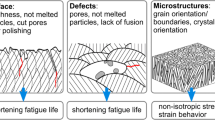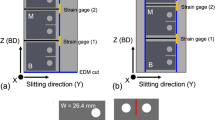Abstract
The researchers are becoming more interested in additive manufacturing (AM). This technology has numerous advantages, particularly in the aerospace, medical and automotive industries. Due to the limited integrity of AM materials, there is a need to do research on this manufacturing technology. The primary concern of engineering applications is a material failure. The fatigue crack growth rate of the AM material, AlSi10Mg, is determined using the S-version finite element method (FEM). The global–local technique was used in the S-version FEM, which consists of two meshes: global and local. S-version FEM concentrated exclusively on the superimposed local crack. The stress intensity factor (SIF) of the crack is calculated using the virtual crack closure method. The SIF value is critical because it has an effect on crack growth. The Newman and Raju (Eng Fract Mech 11(4):817–829, 1979. https://doi.org/10.1016/0013-7944(79)90139-5) equation was used to validate the S-version FEM result. It demonstrates poor agreement due to computational and meshing limitations.









Similar content being viewed by others
References
S.P. Tan, M.A. Ramlan, M.S. Shaari, A. Takahashi, and M.R.M. Akramin, Microstructural and Mechanical Characterization of AlSi10Mg Additively Manufactured Material Using Direct Metal Laser Sintering Technique BT—Technological Advancement in Mechanical and Automotive Engineering (2023), pp. 349–360
M. Jiménez, L. Romero, I.A. Domínguez, M. del Espinosa, M. Domínguez, Additive manufacturing technologies: an overview about 3D printing methods and future prospects. Complexity. 2019, 9656938 (2019). https://doi.org/10.1155/2019/9656938
A. Kanyilmaz et al., Role of metal 3D printing to increase quality and resource-efficiency in the construction sector. Addit. Manuf. 50, 102541 (2022). https://doi.org/10.1016/J.ADDMA.2021.102541
B. Blakey-Milner et al., Metal additive manufacturing in aerospace: a review. Mater. Des. 209, 110008 (2021). https://doi.org/10.1016/J.MATDES.2021.110008
M.R.M. Akramin, M.S. Marizi, M.N.M. Husnain, M. Shamil Shaari, Analysis of surface crack using various crack growth models. J. Phys. Conf. Ser. 1529(4), 42074 (2020). https://doi.org/10.1088/1742-6596/1529/4/042074
R.G. Pettit, Crack growth threshold testing using flat-bottom hole specimens. Eng. Fract. Mech. 249, 107751 (2021). https://doi.org/10.1016/j.engfracmech.2021.107751
A.M. Alshoaibi, Computational simulation of 3D fatigue crack growth under mixed-mode loading. Appl. Sci. 11(13), 5953 (2021). https://doi.org/10.3390/app11135953
Z. Lu, Y. Xiang, Y. Liu, Crack growth-based fatigue-life prediction using an equivalent initial flaw model. Part II: multiaxial loading. Int. J. Fatigue. 32(2), 376–381 (2010). https://doi.org/10.1016/J.IJFATIGUE.2009.07.013
J.C. Newman, E.P. Phillips, M.H. Swain, Fatigue-life prediction methodology using small-crack theory. Int. J. Fatigue. 21(2), 109–119 (1999). https://doi.org/10.1016/S0142-1123(98)00058-9
B. Haghgouyan, B. Young, S. Picak, T. Baxevanis, I. Karaman, D.C. Lagoudas, A unified description of mechanical and actuation fatigue crack growth in shape memory alloys. Acta Mater. 217, 117155 (2021). https://doi.org/10.1016/j.actamat.2021.117155
Q. Xu, J. Chen, H. Yue, J. Li, A study on the S-version FEM for a dynamic damage model. Int. J. Numer. Methods Eng. 115(4), 427–444 (2018). https://doi.org/10.1002/nme.5811
M.R.M. Akramin, A.K. Ariffin, M. Kikuchi, M. Beer, M.S. Shaari, M.N.M. Husnain, Surface crack growth prediction under fatigue load using probabilistic S-version finite element model. J. Braz. Soc. Mech. Sci. Eng. 40(11), 1–14 (2018). https://doi.org/10.1007/s40430-018-1442-8
J. Fish, The s-version of the finite element method. Comput. Struct. 43(3), 539–547 (1992). https://doi.org/10.1016/0045-7949(92)90287-A
H. Okada, M. Higashi, M. Kikuchi, Y. Fukui, N. Kumazawa, Three dimensional virtual crack closure-integral method (VCCM) with skewed and non-symmetric mesh arrangement at the crack front. Eng. Fract. Mech. 72(11), 1717–1737 (2005). https://doi.org/10.1016/j.engfracmech.2004.12.005
M.S. Shaari, A.K. Ariffin, A. Takahashi, S. Abdullah, M. Kikuchi, M.R.M. Akramin, Fatigue crack growth analysis on square prismatic with embedded cracks under tension loading. J. Mech. Eng. Sci. 11(1), 2511–2525 (2017). https://doi.org/10.15282/jmes.11.1.2017.10.0231
Y. Wada, M. Kikuchi, S. Yamada, R. Serizawa, Y. Li, Fatigue growth of internal flaw: simulation of subsurface crack penetration to the surface of the structure. Eng. Fract. Mech. 123, 100–115 (2014). https://doi.org/10.1016/j.engfracmech.2014.03.016
I.S. Raju, J.C. Newman, Stress-intensity factors for a wide range of semi-elliptical surface cracks in finite-thickness plates. Eng. Fract. Mech. 11(4), 817–829 (1979). https://doi.org/10.1016/0013-7944(79)90139-5
Acknowledgments
The author would like to acknowledge the Ministry of Higher Education under Fundamental Research Grant Scheme FRGS/1/2019/TK03/UMP/02/21 (university reference RDU1901151) and Universiti Malaysia Pahang (PGRS220386) for financial support. Also, the authors would like to thank UMP for allowing the research to be conducted using high-performance computer (HPC).
Author information
Authors and Affiliations
Corresponding author
Additional information
Publisher's Note
Springer Nature remains neutral with regard to jurisdictional claims in published maps and institutional affiliations.
This article is an invited paper selected from presentations at the 6th Symposium on Damage Mechanism in Materials and Structures (SDMMS 2022), held August 16–17, 2022 in Kuantan, Malaysia. The manuscript has been expanded from the original presentation. The special issue was organized by Nasrul Azuan Alang, Norhaida Ab Razak, and Aizat Alias, Universiti Malaysia Pahang.
Rights and permissions
Springer Nature or its licensor (e.g. a society or other partner) holds exclusive rights to this article under a publishing agreement with the author(s) or other rightsholder(s); author self-archiving of the accepted manuscript version of this article is solely governed by the terms of such publishing agreement and applicable law.
About this article
Cite this article
Chin, F.Y., Shaari, M.S., Takahashi, A. et al. Fatigue Crack Growth Behavior of AlSi10Mg Material Produced by Direct Metal Laser Sintering Using S-Version Finite Element Method. J Fail. Anal. and Preven. 23, 601–608 (2023). https://doi.org/10.1007/s11668-023-01643-6
Received:
Revised:
Accepted:
Published:
Issue Date:
DOI: https://doi.org/10.1007/s11668-023-01643-6




